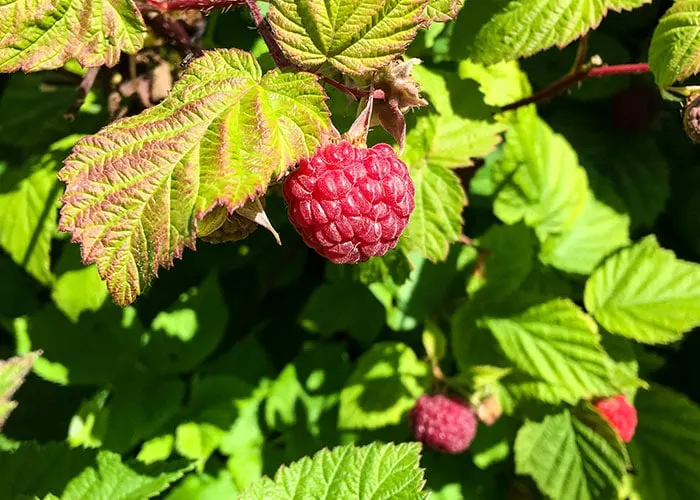This post may contain affiliate links, my full disclosure can be read here. As an Amazon Associate I earn from qualifying purchases.
Learning how to grow raspberries in your backyard garden is so worthwhile. These easy to grow fruit plants need very little care and can provide your family with tasty organic fruit for many years.
Raspberries have to be one of the easiest to grow fruit plants you can choose for your garden.
Since they grow wild throughout North American they easily grow in almost any growing zone and condition from full sun to shade.
They have few pest problems and with just a little care reward you with yummy raspberries that come in many colors from red, yellow, to apricot.

Types Of Raspberries
While there are many varieties of raspberry plants they fall into two different types of plants, summer bearing, and everbearing raspberries.
By their names, it’s easy to tell when each produces fruit but it’s important to know some terms that will help you when picking out what variety to grow and on pruning them later.
- Canes are the stems of the plant.
- Crown is the base of the raspberry plant where the canes grow from.
- Primocanes are the 1st year canes that grow up each spring. The canes are green in color.
- Floricanes are the 2nd year canes. They are easy to recognize by their brown color and have a bark appearance compared to the younger primocanes. Floricanes produce flowers and raspberries.
Summer Bearing
Summer bearing raspberries produce fruit only on the primocanes and are normally ready to harvest in July.
Everbearing
Everbearing raspberries produce fruit on their primocanes in the fall but also on their floricanes in the summer. This means you get two harvests of raspberries from the same plants.
How To Grow Raspberries

Raspberries are one of the hardiest fruits you can grow, thriving in zones 2-7.
They will grow well in full sun to part shade although the more sun they get the more berries the plants seem to produce.
The exception to this is if you live where summers are really hot then giving the plants some afternoon shade could be a better option. This will help protect the leaves and berries from sunburn.
Planting
Raspberries are normally sold as bare root stock in the early spring. But potted plants can be found in nurseries throughout the spring and summer. If you have a friend with a raspberry patch you can also transplant raspberry suckers (young plants) to get started.
The plants are very hardy against frost so you can get them planted as soon as your soil is workable.
Raspberries prefer fertile, well-draining soil. Soil that stays soggy will lead to root rot problems.
If you have heavy clay soil you’ll want to add a lot of good quality compost to amend it before planting or try growing in raised beds to help with drainage.
Likewise, if your soil is very sandy it will drain too fast, and adding compost and deep mulch will keep the soil evenly moist and reduce watering needs.
Before planting bare-root stock soak the roots for 1-2 hours, if you are transplanting potted plants water well a few hours before planting.
Then dig a hole that gives the roots enough room to spread, and deep enough that the crown is 1 inch above the soil level.
If you are planting multiple plants it may be easier to dig a trench instead of individual holes.
Space the canes 18 inches (45.72 cm) apart, then backfill the trench or hole with soil and compost. Firm the soil down to remove any air pockets.
If you are planting multiple rows of raspberries leave at least 4 feet (1.21 m) of space between them as the plants will spread quite a bit.
If desired you can put up a trellis to help support the canes as they grow.
Mulching
After planting place a thick layer of mulch around the plants. This will help hold in moisture and suppress weeds. Wood chips, straw, or shredded leaves all make good mulch options for raspberries.
4 inches (10.16 cm) of mulch is a good start but we had the best results after adding 12 inches (30.48 cm) of wood chip mulch around our plants. They were growing in very sandy, stony soil and struggled to grow until we added the extra deep mulch.
Now the patch goes wild every year with plants and berries.
Watering

Raspberries don’t like soggy soil but they still need consistent watering, especially when they start to produce fruit.
If you haven’t received 1 inch (2.54 cm) of rainfall, make sure to supplement each weak from when the plants start to grow in the spring until after you have harvested the berries.
Plants that receive less then 1 inch (2.54 cm) of water per week are more likely to have smaller berries.
Fertilizing
Adding 1-2 inches (2.54-5.08 cm) of compost to your raspberry patch in the fall is a great way to fertilize them and improve your soil quality at the same time.
If you don’t have access to compost you can also fertilize the plants with a balanced 10-10-10 fertilizer for fruiting shrubs.
Pruning
Although raspberry plants are perennials the canes only live and produce for 2 years so pruning is very important in keeping a healthy fruit patch.
To prune summer bearing raspberries simply cut back all the canes that produced fruit for you to ground level. These will be the older brown canes and they will not produce fruit for you next year.
Leave the younger green stemmed canes as these are your fruit bearers for next year.
For everbearing raspberries, you have two options for pruning them depending on if you want one harvest or two from them.
Like the summer bearing varieties in the 2nd year, Floricanes should be cut back after harvesting or in the late winter before the plants start to grow.
But if you want both a summer and fall harvest don’t cut back the primocanes that produced your fall crop all the way. Instead cut them back about 12 inches (30.48 cm) or until you get to the green wood that will be just below where the cane stopped producing fruit last year.
If you don’t care about getting 2 harvests then you can simply cut the entire stand of canes back to ground level in the winter. The new canes that come up in the spring will produce your main harvest and it requires much less pruning time.
Trellising
You’ll find a wide range of heights available with raspberry plants.
My favorites to grow are the everbearing types, they are often short and strong plants that don’t need trellising.
But many of the summer bearing types grow huge canes that can get taller than an average person. These canes can be weak and need support so they don’t break or fall over when covered in fruit.
You can use any type of support you like but a common way is to add posts at the end of each row and along the row if it’s long. Then string wire from post to post forming a long rectangle of wires.
Let the canes grow up between them and they can rest on the wires. Some like to tie the canes to the wires to give more support.
Harvesting
If you’ve ever gone raspberry picking you’ll realize just how simple this part is.
You harvest raspberries after they have changed color and look ripe.
While holding the berry pull downwards gently and if it separates easily from the white center that attaches it to the plant it’s ripe and ready to pick.
If the berry doesn’t come off easily then leave it to ripen a little longer.
Raspberries are easily bruised and crushed to pick them gently and place them into shallow containers. Use or refrigerate the berries as soon as possible after picking.
If you have raspberries with thorns then wearing long sleeves and thorn proof gloves can be helpful to prevent scratches.
Connect With Homestead Acres!
Be sure to follow me on social media, so you never miss a post!
Facebook | Twitter | Pinterest | Twitter
Visit my Amazon store to find all my favorite gardening, homesteading tools, and gadgets plus all of my printed garden books and journals!

Kim Mills is a homeschooling mom of 6 and lives on an urban homestead in Ontario, Canada. Blogging at Homestead Acres she enjoys sharing tips to help you save money, grow and preserve your own food.
